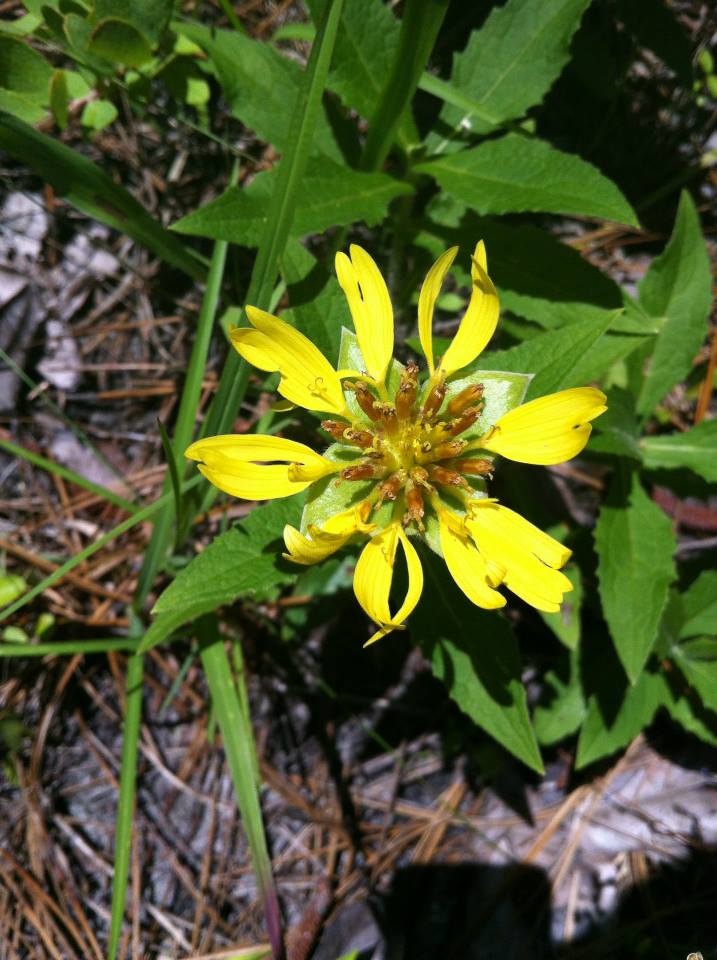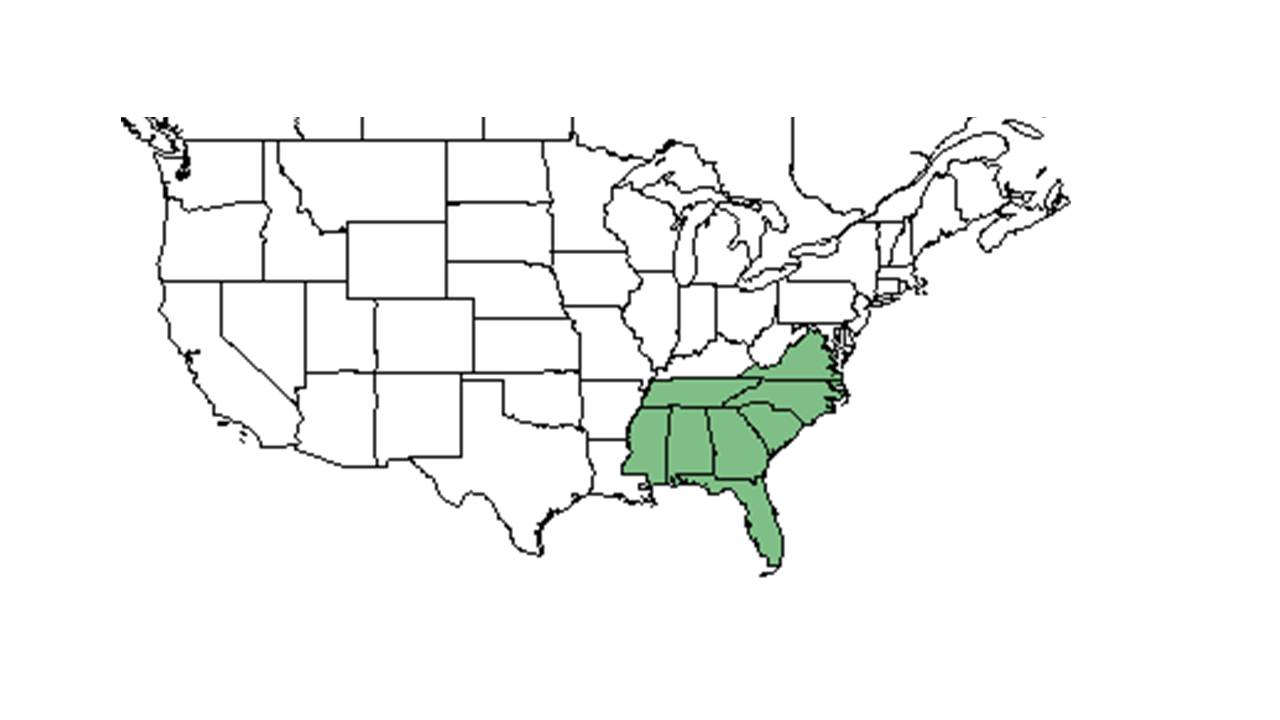Difference between revisions of "Tetragonotheca helianthoides"
HaleighJoM (talk | contribs) (→Ecology) |
|||
| (4 intermediate revisions by 2 users not shown) | |||
| Line 27: | Line 27: | ||
==Ecology== | ==Ecology== | ||
===Habitat=== <!--Natural communities, human disturbed habitats, topography, hydrology, soils, light, fire regime requirements for removal of competition, etc.--> | ===Habitat=== <!--Natural communities, human disturbed habitats, topography, hydrology, soils, light, fire regime requirements for removal of competition, etc.--> | ||
| − | In the Coastal Plain in Florida, ''T. helianthoides'' has been found growing in the shade of a oak-hickory forest; loamy sand along the edge of a oak-pine-sassafras secondary woodland; loamy sand along wet pine flatwoods; scrub oak woods; mixed oak woodland; mixed deciduous flatwoods; longleaf pine slope above a ''Chamaecyparis'' thicket; scrub oak sandridge; wet depressions; burned longleaf pinewoods; sandy oak-pine forested uplands; loamy sand of pine-oak slopes above small seepage slopes; pine-turkey oak woods; and slash pine-scrub oak flats; and the ecotone between mixed hardwoods and fire-maintained pine-oak woods. <ref name="FSU Herbarium">Florida State University Robert K. Godfrey Herbarium database. URL: [http://herbarium.bio.fsu.edu http://herbarium.bio.fsu.edu]. Last accessed: July 2015. Collectors: Loran C. Anderson, Gary R. Knight, R.K. Godfrey, Sidney McDaniel, D. B. Ward, D. Burch, Richard S. Mitchell, B. L. Turner, R. Kral, Wilson Baker, William T. Gillis, Ira L. Wiggins, Dorothy B. Wiggins, Gwynn W. Ramsey, H. L. Stripling, Carol H. Beck, Robert F. Martin, R. A. Norris, R. Komarek, Lisa Keppner, Bill Boothe, Marcia Boothe, Annie Schmidt, A. Johnson, M. Jenkins, B. Cole Irvin. States and Counties: Florida: Alachua, Calhoun, Columbia, Escambia, Gadsden, Holmes, Jackson, Lafayette, Lake, Leon, Madison, Marion, Santa Rosa, Wakulla, Walton, Washington. Georgia: Grady. Compiled by Tall Timbers Research Station and Land Conservancy.</ref> <ref name="Heuberger et al. 2003">Heuberger, K. A. and F. E. Putz. 2003. Fire in the suburbs: ecological impacts of prescribed fire in small remnants of longleaf pine (''Pinus palustris'') sandhill. Restoration Ecology 11:72-81.</ref> It has been observed to grow in disturbed habitats such as powerline corridors, open fields, and roadside ditches. | + | In the Coastal Plain in Florida, ''T. helianthoides'' has been found growing in the shade of a oak-hickory forest; loamy sand along the edge of a oak-pine-sassafras secondary woodland; loamy sand along wet pine flatwoods; scrub oak woods; mixed oak woodland; mixed deciduous flatwoods; longleaf pine slope above a ''Chamaecyparis'' thicket; scrub oak sandridge; wet depressions; burned longleaf pinewoods; sandy oak-pine forested uplands; loamy sand of pine-oak slopes above small seepage slopes; pine-turkey oak woods; and slash pine-scrub oak flats; and the ecotone between mixed hardwoods and fire-maintained pine-oak woods.<ref name="FSU Herbarium">Florida State University Robert K. Godfrey Herbarium database. URL: [http://herbarium.bio.fsu.edu http://herbarium.bio.fsu.edu]. Last accessed: July 2015. Collectors: Loran C. Anderson, Gary R. Knight, R.K. Godfrey, Sidney McDaniel, D. B. Ward, D. Burch, Richard S. Mitchell, B. L. Turner, R. Kral, Wilson Baker, William T. Gillis, Ira L. Wiggins, Dorothy B. Wiggins, Gwynn W. Ramsey, H. L. Stripling, Carol H. Beck, Robert F. Martin, R. A. Norris, R. Komarek, Lisa Keppner, Bill Boothe, Marcia Boothe, Annie Schmidt, A. Johnson, M. Jenkins, B. Cole Irvin. States and Counties: Florida: Alachua, Calhoun, Columbia, Escambia, Gadsden, Holmes, Jackson, Lafayette, Lake, Leon, Madison, Marion, Santa Rosa, Wakulla, Walton, Washington. Georgia: Grady. Compiled by Tall Timbers Research Station and Land Conservancy.</ref><ref name="Heuberger et al. 2003">Heuberger, K. A. and F. E. Putz. 2003. Fire in the suburbs: ecological impacts of prescribed fire in small remnants of longleaf pine (''Pinus palustris'') sandhill. Restoration Ecology 11:72-81.</ref> It has been observed to grow in disturbed habitats such as powerline corridors, open fields, and roadside ditches. |
| − | Substrate types include sand, red sandy soil, gravel, and loamy sand. <ref name="FSU Herbarium"/> Associated species include ''Myrica, Liquidambar'', and ''Chamaecyparis.'' <ref name="FSU Herbarium"/> | + | Substrate types include sand, red sandy soil, gravel, and loamy sand.<ref name="FSU Herbarium"/> Associated species include ''Myrica, Liquidambar'', and ''Chamaecyparis.''<ref name="FSU Herbarium"/> |
===Phenology=== <!--Timing off flowering, fruiting, seed dispersal, and environmental triggers. Cite PanFlora website if appropriate: http://www.gilnelson.com/PanFlora/ --> | ===Phenology=== <!--Timing off flowering, fruiting, seed dispersal, and environmental triggers. Cite PanFlora website if appropriate: http://www.gilnelson.com/PanFlora/ --> | ||
| − | It has been observed flowering and fruiting April through July. <ref name="FSU Herbarium"/> | + | It has been observed flowering and fruiting April through July.<ref name="FSU Herbarium"/><ref>Nelson, G. [http://www.gilnelson.com/ PanFlora]: Plant data for the eastern United States with emphasis on the Southeastern Coastal Plains, Florida, and the Florida Panhandle. www.gilnelson.com/PanFlora/ Accessed: 19 MAY 2021</ref> |
| − | |||
<!--===Seed dispersal===--> | <!--===Seed dispersal===--> | ||
<!--===Seed bank and germination===--> | <!--===Seed bank and germination===--> | ||
| + | |||
===Fire ecology=== <!--Fire tolerance, fire dependence, adaptive fire responses--> | ===Fire ecology=== <!--Fire tolerance, fire dependence, adaptive fire responses--> | ||
| − | Arata noted that ''T. helianthoides'' appeared in late May/ early June after burning in mid-winter. <ref name="Arata 1959">Arata, A. A. 1959. Effects of burning on vegetation and rodent populations in a longleaf pine-turkey oak association in north central Florida. Quarterly Journal of the Florida Academy of Sciences 22:94-104.</ref> | + | Arata noted that ''T. helianthoides'' appeared in late May/ early June after burning in mid-winter.<ref name="Arata 1959">Arata, A. A. 1959. Effects of burning on vegetation and rodent populations in a longleaf pine-turkey oak association in north central Florida. Quarterly Journal of the Florida Academy of Sciences 22:94-104.</ref> |
| − | <!--===Pollination===--> | + | <!--===Pollination===--> |
| − | <!--=== | + | <!--===Herbivory and toxicology=== <!--Common herbivores, granivory, insect hosting, poisonous chemicals, allelopathy, etc.--> |
<!--===Diseases and parasites===--> | <!--===Diseases and parasites===--> | ||
| − | ==Conservation and | + | |
| − | == | + | ==Conservation, cultivation, and restoration== |
| + | |||
| + | ==Cultural use== | ||
==Photo Gallery== | ==Photo Gallery== | ||
<gallery widths=180px> | <gallery widths=180px> | ||
Latest revision as of 08:14, 18 July 2022
| Tetragonotheca helianthoides | |
|---|---|

| |
| Photo taken by Michelle M. Smith | |
| Scientific classification | |
| Kingdom: | Plantae |
| Division: | Magnoliophyta – Flowering plants |
| Class: | Magnoliopsida – Dicotyledons |
| Order: | Asterales |
| Family: | Asteraceae ⁄ Compositae |
| Genus: | Tetragonotheca |
| Species: | T. helianthoides |
| Binomial name | |
| Tetragonotheca helianthoides L. | |

| |
| Natural range of Tetragonotheca helianthoides from USDA NRCS Plants Database. | |
Common names: Pineland nerveray, Pineland-ginseng, Squarehead
Contents
Taxonomic notes
Description
A description of Tetragonotheca helianthoides is provided in The Flora of North America.
Distribution
Ecology
Habitat
In the Coastal Plain in Florida, T. helianthoides has been found growing in the shade of a oak-hickory forest; loamy sand along the edge of a oak-pine-sassafras secondary woodland; loamy sand along wet pine flatwoods; scrub oak woods; mixed oak woodland; mixed deciduous flatwoods; longleaf pine slope above a Chamaecyparis thicket; scrub oak sandridge; wet depressions; burned longleaf pinewoods; sandy oak-pine forested uplands; loamy sand of pine-oak slopes above small seepage slopes; pine-turkey oak woods; and slash pine-scrub oak flats; and the ecotone between mixed hardwoods and fire-maintained pine-oak woods.[1][2] It has been observed to grow in disturbed habitats such as powerline corridors, open fields, and roadside ditches.
Substrate types include sand, red sandy soil, gravel, and loamy sand.[1] Associated species include Myrica, Liquidambar, and Chamaecyparis.[1]
Phenology
It has been observed flowering and fruiting April through July.[1][3]
Fire ecology
Arata noted that T. helianthoides appeared in late May/ early June after burning in mid-winter.[4]
Conservation, cultivation, and restoration
Cultural use
Photo Gallery
References and notes
- ↑ 1.0 1.1 1.2 1.3 Florida State University Robert K. Godfrey Herbarium database. URL: http://herbarium.bio.fsu.edu. Last accessed: July 2015. Collectors: Loran C. Anderson, Gary R. Knight, R.K. Godfrey, Sidney McDaniel, D. B. Ward, D. Burch, Richard S. Mitchell, B. L. Turner, R. Kral, Wilson Baker, William T. Gillis, Ira L. Wiggins, Dorothy B. Wiggins, Gwynn W. Ramsey, H. L. Stripling, Carol H. Beck, Robert F. Martin, R. A. Norris, R. Komarek, Lisa Keppner, Bill Boothe, Marcia Boothe, Annie Schmidt, A. Johnson, M. Jenkins, B. Cole Irvin. States and Counties: Florida: Alachua, Calhoun, Columbia, Escambia, Gadsden, Holmes, Jackson, Lafayette, Lake, Leon, Madison, Marion, Santa Rosa, Wakulla, Walton, Washington. Georgia: Grady. Compiled by Tall Timbers Research Station and Land Conservancy.
- ↑ Heuberger, K. A. and F. E. Putz. 2003. Fire in the suburbs: ecological impacts of prescribed fire in small remnants of longleaf pine (Pinus palustris) sandhill. Restoration Ecology 11:72-81.
- ↑ Nelson, G. PanFlora: Plant data for the eastern United States with emphasis on the Southeastern Coastal Plains, Florida, and the Florida Panhandle. www.gilnelson.com/PanFlora/ Accessed: 19 MAY 2021
- ↑ Arata, A. A. 1959. Effects of burning on vegetation and rodent populations in a longleaf pine-turkey oak association in north central Florida. Quarterly Journal of the Florida Academy of Sciences 22:94-104.